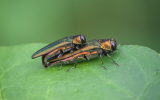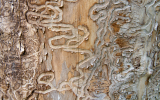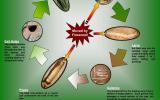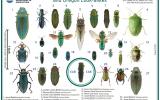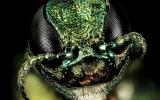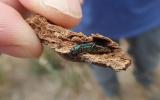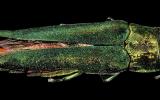Emerald Ash Borer
The beetle destroying millions of ash trees across North America
Corvallis Plan of Action
The City of Corvallis is taking proactive steps to address the incoming presence of the Emerald Ash Borer (EAB). This invasive beetle poses a significant threat to ash trees, leading to widespread tree loss and damage.
To protect our urban forest and stay ahead of the destruction that will be caused by EAB, we must begin removing and replacing ash trees that meet the following criteria:
- Planted in poor locations (near structures, utilities, or in small planter strips)
- Planted underneath high-voltage power lines
- In poor health
To minimize the impact of EAB and preserve the overall health of our tree canopy, the City is implementing a five-year plan to reduce the number of city-managed ash trees by approximately one-third. This equates to the removal and replacement of about 100 trees per year, starting with those in the worst condition and most problematic locations.
These trees will be replaced, in time, with suitable species to maintain the beauty and ecological balance of our neighborhoods. By acting now, we can minimize the spread and concentrated destruction of EAB and ensure a healthier, more resilient urban forest for the future.
For more information or to learn about the tree planting program, please contact the Urban Forester at 541-754-1723.
State of Oregon Response Plan
Oregon Tree Health Threats
Emerald Ash Borer Background
Emerald Ash Borer (Agrilus planipennis) is a small, wood boring beetle that attacks and kills all ash trees (Fraxinus species). First discovered near Detroit, Michigan in 2002, this beetle has killed hundreds of millions of ash trees across the Midwestern and Eastern United States. Native to Asia, it’s thought that EAB arrived on infested shipping material. Although the beetle can fly, it is transported easily and across great distances in infested dead ash logs and firewood. Unlike in its native range, EAB has no known predators here, resulting in up to a 99% mortality rate. In Oregon, our native Oregon Ash (Fraxinus latifolia) is at high risk. Depending on the size and condition of the tree, it can die within 3-5 years of the infestation.
Oregon: On June 30th 2022, a report came in to ODF, EAB was first detected in Forest Grove, Oregon, marking the 36th state to find EAB, and first known infestation west of Colorado. Found in a school parking lot, the initial find was 16 green ash. Based on observations from experienced entomologists, it is believed that this beetle has been present on this site for 3-5 years. Within 24 hours, all trees were removed and chipped, but not before a green funnel trap captured 285 adult EABs. Oregon Department of Forestry and Oregon Department of Agriculture are working on a compressive search and detection of the immediately infested area, using the Emerald Ash Borer Readiness and Response Plan for Oregon as a guide in their response.
Oregon Department of Agriculture has taken the lead in a major inter-agency ash tree survey, surveying thousands of trees since July 2022.
How to Identify EABs
Adult Beetles are ¼-1/2 inches long, narrow, and bullet-shaped. They are brilliantly metallic-green in color with purple and red abdomen. The larvae can get up to 3 cm long and are creamy-white in color with flattened, bell-shaped segments.
Emerald Ash Borer Life Cycle (based on local growing degree days): June through September, very small (1mm) eggs are deposited in bark crevices. These eggs are so small and well-hidden that they are nearly impossible to detect. As larvae hatch from the eggs, they immediately chew into the tree. Females can lay 60-90 eggs. Larvae tunnel and feed in the tissue immediately beneath the bark. They wind back and forth, creating S- shaped patterns called galleries. This is the most destructive stage because the galleries disrupt the flow of nutrients in the tree. These larvae can overwinter for one or two years and survive in green wood, even in firewood. In the spring, EAB transform into adult beetles emerge from the tree. Adult beetles feed on the edges of the leaves, but is quite minor.
Check out photos of the EAB lifecycle from the University of Wisconsin.
There are many common look-alikes to the EAB, see the Oregon Department of Agriculture's EAB Look-alikes.
How to Identify Ash Trees
Only true ash trees are susceptible to EAB. Ash trees branches and buds grow directionally across from each other (opposite) and are not staggered (alternate). Leaves are compound and composed of 5-11 leaflets. The bark of mature ash trees have a distinct diamond-shaped pattern. Young bark can be relatively smooth. Ash seeds are dry and oar-shaped. They appear in clusters and are present on the tree until late fall. While many trees share one or two of these characteristics, only ash have all three!
- This is an excellent guide from Michigan State University
- NOT ash trees:
- Boxelder (Acer Negundo) The only other oppositely-branched tree with compound leaves is boxelder (Acer negundo) which has 3-5 leaflets.
- European Mountain Ash (Sorbus aucuparia), not a member of the ash family but shares a common name.
- Shagbark Hickory (Carya ovata)
- Black Walnut (Juglans nigra)
Corvallis ash trees: The Corvallis Urban Forestry manages all of the trees in the City-owned public right of ways and parks. Our tree inventory software, Davey Treekeeper, shows all of the inventoried ash trees, almost 1700, but tens of thousands un-inventoried ash exist in our riparian corridors and natural areas. We have no mechanism to add these to our inventory at this time but are still monitoring for Emerald Ash Borer.
- To see a map of all inventoried ash, visit Davey TreeKeeper.
- Click the magnifying glass
- Click on “Select Quick Filters”
- Select “Ash Trees”
What is that purple thing in the tree? The City of Corvallis participates in a state-wide trapping program to help detect early signs of the beetle. During their adult state, EABs fly around the trees. The traps are baited with a chemical lure designed to mimic the smell of a dying ash tree. The insides of the trap are coated with a glue so that flying adult beetles get stuck to the sides. The traps are checked twice during the summer for the presence of adult beetles. This trap is not a population control mechanism to reduce or deplete populations, but a detection tool used to monitor the spread of the beetle. Corvallis hung and monitored 20 traps in during the summer of 2023. More information on trapping can be found here.
Do you think your tree has EABs?
- It is important to note that stressed trees (like those suffering from prolonged drought or heat) can often mimic early signs of EAB.
- Canopy dieback: a result of larval feeding, which disrupts the flow of nutrients and water to the canopy. Trees typically show initial signs of thinning at the very top of the tree. This symptom alone does not mean the tree has EAB.
- Epicormic sprouting: Sometimes called sucker sprouts or water sprouts, these adventitious growths are often the first sign of stress. This growth along the trunk and base of the tree is a response to the tree’s loss of upper canopy and can happen just below where the larvae are feeding. This symptom alone does not mean the tree has EAB.
- Bark splits: these vertical splits in the bark are the tree’s response to the destructive galleries.
- Woodpecker flecking: while woodpecker activity is very common, even in healthy trees, this type of flecking is specific to EAB. Woodpeckers pick away at the outer bark of infested trees to access the tunneling larvae directly beneath the bark.
- Galleries: As larvae feed under the bark, they create these characteristic, S-shaped galleries that are specific in ash trees to EAB. These galleries are packed with frass, the digested woody material created by these wood-boring insects.
- Larvae: The larvae are cream-colored with bell-shaped segments. Fully grown, they can reach 1.5 inches long.
- D-shaped exit holes: As adults emerge from under the bark, they create a perfect capitol D-shaped exit hole. These holes are small, about 1/8 diameter and can be oriented any direction.
- Adult beetles: are brilliantly metallic-green in color and bullet-shaped. They are small, you can easily fit 2 adults on a single penny.
- For more information on signs and symptoms of the beetle, check out this bulletin from Michigan State University Extension.
Report a Problem Tool
Do you suspect your tree has EAB? Immediately contact Urban Forestry at urbanforestry@corvallisoregon.gov
And report online at the Oregon invasive species hotline or call 1-866-INVADER.
How You Can Help
-
- Volunteer to replace ash canopy all over the City! Neighborhood Tree Stewards. Do you have a love for trees and want to make positive changes in your community? For more information on how to be a volunteer tree planter with Corvallis Urban Forestry, email urbanforestry@corvallisoregon.gov or call 541-754-1723.
- Protect the trees you love! Don’t move firewood
- Become an Oregon Forest Pest Detector through Oregon State University Extension Services! This free program will train you to be on the front line of early pest detection for Emerald Ash Borer and other dangerous forest pests!
- Call if you think your tree has EAB: 1-866-INVADER or Report an Emerald Ash Borer Online

